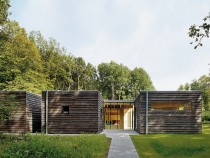
© Hagen Stier
The small nursery school on Hamburg’s northeast side occupies an unusually large site. The children who attend the facility have a surface area of 7000 qm available to them in which they can play amid mature trees. The relationship to nature is an important part of the school’s pedagogic concept. The architects developed a design that allowed them to integrate the volume in the small-scale fabric of a neighbourhood consisting primarily of single-family homes: they apportioned the building massing in smaller subunits. Each of the classrooms has an adjoining quiet room and lavatory. The kitchen and the auxiliary spaces are grouped around a shared space for active play.
At the very centre of the nursery school is a compact atrium that brings daylight into the interiors. The corridor surrounding the space for active play – reminiscent of a cloister – may also be used by the children for varying activities. It is spatially and acoustically uncoupled by means of a floor-to-ceiling, porous wall that is infilled with wood or glass. Different programmatic functions – such as the children’s cubbyholes, seating nooks for both children and adults, shelving and storage space – are integrated in these walls. Because the latter are transparent, staff members can keep an eye on the goings-on in the house. On top of that, the walls forge a visual link to the vegetation.
At the very centre of the nursery school is a compact atrium that brings daylight into the interiors. The corridor surrounding the space for active play – reminiscent of a cloister – may also be used by the children for varying activities. It is spatially and acoustically uncoupled by means of a floor-to-ceiling, porous wall that is infilled with wood or glass. Different programmatic functions – such as the children’s cubbyholes, seating nooks for both children and adults, shelving and storage space – are integrated in these walls. Because the latter are transparent, staff members can keep an eye on the goings-on in the house. On top of that, the walls forge a visual link to the vegetation.






